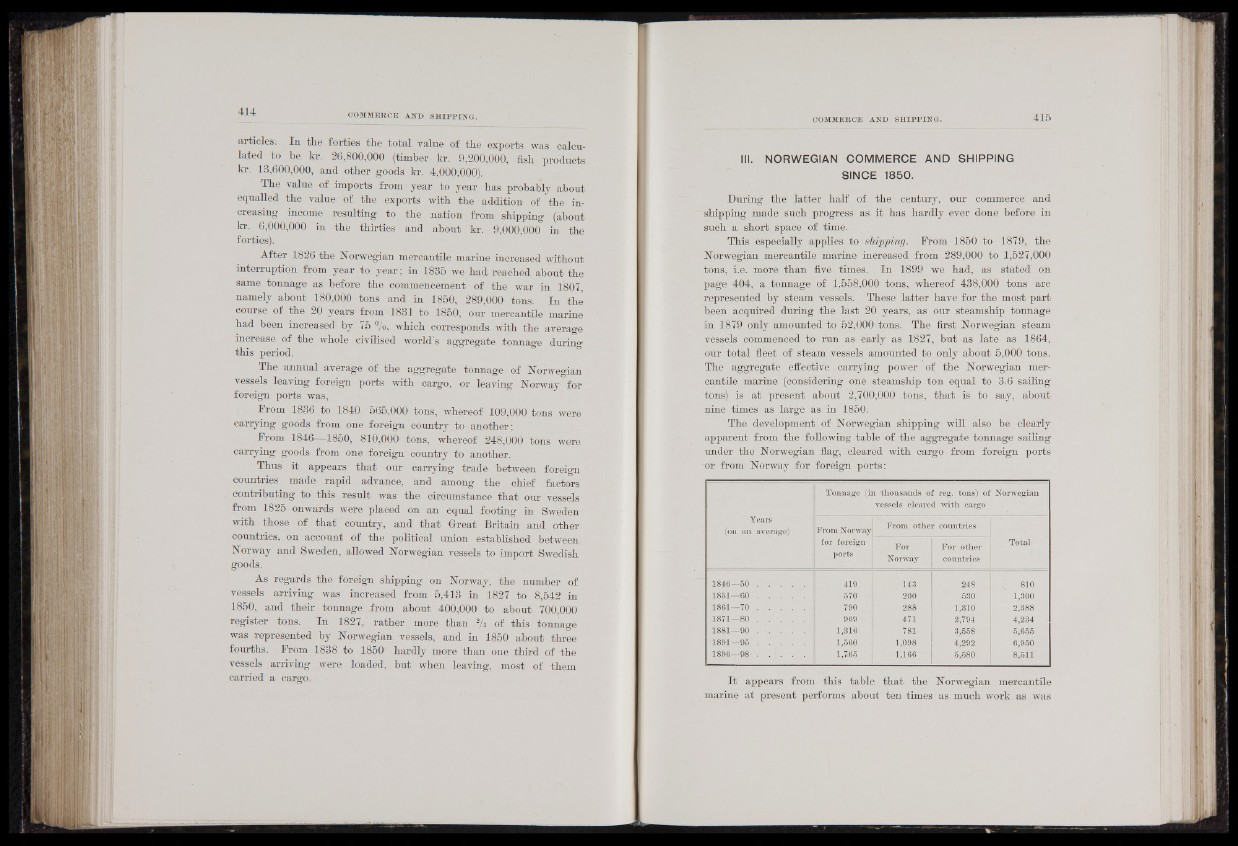
articles. In the forties the total value of the exports was calculated
to be hr. 26,800,000 (timber kr. 9,200,000, fish products
kr. 13,600,000, and other goods kr. 4,000,000).
The value of imports from year to year has probably about
equalled the value of the exports with the addition of the increasing
income resulting to the nation from shipping (about
kr. 6,000,000 in the thirties and about kr. 9,000,000 in the
forties).
After 1826 the Norwegian mercantile marine increased without
interruption from year to year ; in 1835 we had reached about the
same tonnage as before the commencement of the war in 1807,
namely about 180,000 tons and in 1850, 289,000 tons. In thè
course of the 20 years from 1831 to 1850, our mercantile marine
had been increased by 75 °/o, which corresponds with the average
increase of the whole civilised world’s aggregate tonnare durino'
this period.
The annual average of the aggregate tonnage of Norwegian
vessels leaving foreign ports with cargo, or leaving Norway for
foreign ports was,
From 1836 to 1840 565,000 tons, whereof 109,000 tons were
carrying goods from one foreign country to another;
From 1846—1850, 810,000 tons, whereof 248,000 tons were
carrying goods from one foreign country to another.
Thus it appears that our carrying trade between foreign
countries made rapid advance, and among the chief factors
contributing to this result was the circumstance that our vessels
from 1825 onwards were placed on an equal footing in Sweden
with those of th a t, country, and that Great Britain and other
countries, on account of the political union established between
Norway and Sweden, allowed Norwegian vessels to import Swedish
goods.
As regards the foreign shipping on Norway, the number of
vessels arriving was increased from 5,413 in 1827 to 8,542 in
1850, and their tonnage from about 400,000 to about 700,000
register tons. In 1827, rather more than 2/s of this tonnage
was represented by Norwegian vessels, and in 1850 about three
fourths. From 1838 to 1850 hardly more than one third of the
vessels arriving were loaded, but when leaving, most of them
carried a cargo.
III. NORWEGIAN COMMERCE AND SHIPPING
SINCE 1850.
During the latter half of the century, our commerce and
shipping made such progress as it has hardly ever done before in
such a short space of time.
This especially applies to shipping. From 1850 to 1879, the
Norwegian mercantile marine increased from 289,000 to 1,527,000
tons, i.e. more than five times. In 1899 we had, as stated on
page 404, a tonnage of 1,558,000 tons, whereof 438,000 tons are
represented by steam vessels. These latter have for the most part
been acquired during the last 20 years, as our steamship tonnage
in 1879 only amounted to 52,000 tons. The first Norwegian steam
vessels commenced to run as early as 1827, but as late as 1864,
our total fleet of steam vessels amounted to only about 5,000 tons.
The aggregate effective carrying power of the Norwegian mercantile
marine (considering one steamship ton equal to 3.6 sailing
tons) is at present about 2,700,000 tons, that is to say, about
nine times as large as in 1850.
The development of Norwegian shipping will also be clearly
apparent from the following table of the aggregate tonnage sailing
under the Norwegian flag, cleared with cargo from foreign ports
or from Norway for foreign ports:
Years
. (oil an average)
Tonnage (in thousands of reg. tons) of Norwegian
vessels cleared with cargo
From Norway
for foreign
ports
From othe
. For
Norway
countries
For other
countries
Total
11846—50 . . . . . | 419 143 248 810
1851—60 ..................... 670 • 200 530 ; 1,300
1861—7 .0 ..................... 790 288 1,310 2,388
1871—80 . . . . . 969 471 2,794 4,234
1881—90 ..................... 1,316 781 3,558 6,656 '
1891—95 . . . . . 1,660 1,098 4,292 6,950
1896—98 . . . . . . . 1,765 1,166 6,580 8,511
I t appears from this table that the Norwegian mercantile
marine at present performs about ten times as much work as was